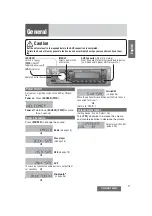
Page 26
Large-scale Decoder & Sound Decoder MX695/6/7/9
step 2 = 2 km/h,
step 3 = 3 km/h…
= 20: each step represents 2 km/h;
step 1 = 2 km/h, step 2 = 4 km/h,
last step 126 = 253 km/h.
= 5: each step represents
.
5 km/h;
step 1 =
.
5 km/h, step 2 = 1 km/h,
last step 126 = 63 km/h.
#136
Km/h
–
Speed regulation
-
Control number
read-out
or
speed setting confir-
mation
Calibration
run
or
RailCOm
read-out
factor
Read
value
128
A numeric value can be read-out after a successful
calibration run, which was used to calculate the
speed. It should remain unchanged (or vary only
slightly) even after multiple calibration runs.
or
correction factor for speed confirmation via RailCom
or other method of bidirectional communication.
Mph (miles per hour) instead of km/h
:
Extending the calibration distance accordingly results in a mph speed regulation!
5.9
The ZIMO
“signal controlled speed influence” (HLU)
ZIMO digital systems offer a second level of communication for transmitting data to vehicles in
specific track sections. The most common application for this is the “signal controlled speed in-
fluence” for stopping trains and applying speed limits in 5 stages, with data sent to the track
sections as needed in the form of HLU cut-outs prepared by MX9 track section modules or its
successors. This feature only operates within ZIMO systems.
If the “signal controlled speed influence” is being used (only possible within a ZIMO system),
the speed limits “U” and “L” (and the intermediate steps if needed) can be set with configura-
tion variables CV’s #51 to #55 as well as acceleration and deceleration values (momentum)
with CV #49 and #50.
Please note that the signal controlled acceleration and deceleration times in CV #49 and #50
are always
added
to the times and curves programmed to CV #3, 4, 121, 122 etc. Signal con-
trolled accelerations and decelerations compared to cab controlled momentum can therefore
only progress either at the same rate (if CV #49 and #50 is not used) or slower (if CV #49
and/or #50 contain a value of >0), but never faster.
In order to have a properly functioning train control system using the signal controlled speed
influence, it is important that all tracks are laid out correctly, especially the stopping and pre-
braking/deceleration sections of the track. Please consult the MX9 instruction manual.
It is of utmost importance for a flawlessly working train control system using the signal con-
trolled speed influence that the stop and related brake section lengths are arranged properly
and consistently everywhere on the layout. Please consult the MX9 instruction manual.
The deceleration (often CV #52 for “U” limit) and brake (CV #4 and #50) characteristics should
be set so that all locos come to a complete stop within about 2/3 of the stop section, which in
large-
scale is typically 2’ - 2 ½’ before the end of a stop section. Setting the loco up to stop
precisely within the last inch of a stop section is not recommended.
CV
Designation
Range
Default Description
CV
Designation
Range
Default Description
#49
Signal controlled
(HLU)
acceleratio
n
0 - 255
0
Entered value multiplied by .4 equals acceleration
time in seconds from stop to full speed
when:
“ZIMO signal controlled speed influence” with ZIMO
MX9 track section module or successor
or
“asymmetrical DCC signal” method (Lenz ABC) is
employed
#50
Signal controlled
(HLU)
deceleration
0 - 255
0
Entered value multiplied by .4 equals deceleration
time in seconds from full speed to complete stop
when:
“ZIMO signal controlled speed influence” with
ZIMO MX9 track section module or successor
or
“asymmetrical DCC signal” method (Lenz ABC) is
employed
#51
#52
#53
#54
#55
Signal dependent
(HLU) speed limits
#52 for “U”,
#
54 for “L”,
#51, 53, 55 for
intermediate steps
0 - 255
20
40 (U)
70
110 (L)
180
ZIMO “signal controlled speed influence” method
(HLU) using MX9 or successor:
Defines the internal speed steps for each of the 5
speed limits generated via HLU.
#59
Signal dependent
reaction time
0 - 255
5
ZIMO signal controlled speed influence (HLU) with
ZIMO MX9 track section module or future module
or
when using the “asymmetrical DCC signal” stopping
method (Lenz ABC):
Time in tenth of a second until the locomotive starts to
accelerate after receiving a higher signal controlled
speed limit command.
5.10
“Asymmetrical DCC-Signal” stops (Lenz ABC)
The “asymmetrical DCC signal” is an alternative method for stopping trains at a “red” signal. A
simple circuit made up of 4 or 5 commercially available diodes is all that is required.
Usually
3 - 5 diodes in series plus one
Schottky diode in parallel in opposite
direction is connected
to the stop sec-
tion. The different voltage drops across
the diodes results in an asymmetry of
about 1 to 2V. The direction in which the
diodes are mounted determines the po-
larity of the asymmetry and with it the
driving direction a signal stop is initiated.
Содержание MX695
Страница 6: ...Page 6 Large scale Decoder Sound Decoder MX695 6 7 9 ...
Страница 7: ...Large scale Decoder Sound Decoder MX695 MX696 MX697 MX699 Page 7 MX697 ...
Страница 8: ...Page 8 Large scale Decoder Sound Decoder MX695 6 7 9 ...
Страница 14: ...Page 14 Large scale Decoder Sound Decoder MX695 6 7 9 ...
Страница 15: ...Large scale Decoder Sound Decoder MX695 MX696 MX697 MX699 Page 15 ...
















































